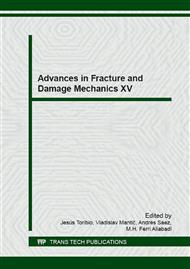p.66
p.70
p.74
p.78
p.82
p.86
p.90
p.94
p.99
Evaluation of Fatigue Strength of Different Thickness Laser Welded S355 Steel Sheets Considering Microstructure, Surface Conditions and Residual Stresses
Abstract:
The paper contains results of experimental programme aimed at evaluation of fatigue resistance of laser welded 6 mm and 10 mm thick sheets of a low alloy structural S355 steel. High cycle fatigue tests were performed to verify fatigue strength of the sheets containing laser welds performed with optimised laser welding parameters. Surface of the sheets was in as-received conditions simulating real welding applications. The results are compared to each other and to fatigue S-N curve of the S355 material evaluated on quite small standard specimens. Endurance limit of the 10 mm thick laser welded sheet was by more than by 30% higher than that of the 6 mm thick sheet. In connection with this effect, all fatigue cracks in the 6 mm thick sheets initiated in the weld area unlike the 10 mm sheet, where cracks initiated both in the weld area and outside it indicating no or just minor unfavourable effect of the welding. However, fatigue strength and endurance limit of small material specimens were considerably higher even in comparison with the 10 mm welded sheets. The results are discussed considering, results of microstructure analyses, different values and distribution of residual stresses and also differences between surface conditions of the sheets and the standard specimens.
Info:
Periodical:
Pages:
82-85
Citation:
Online since:
September 2016
Keywords:
Price:
Сopyright:
© 2016 Trans Tech Publications Ltd. All Rights Reserved
Share:
Citation:


